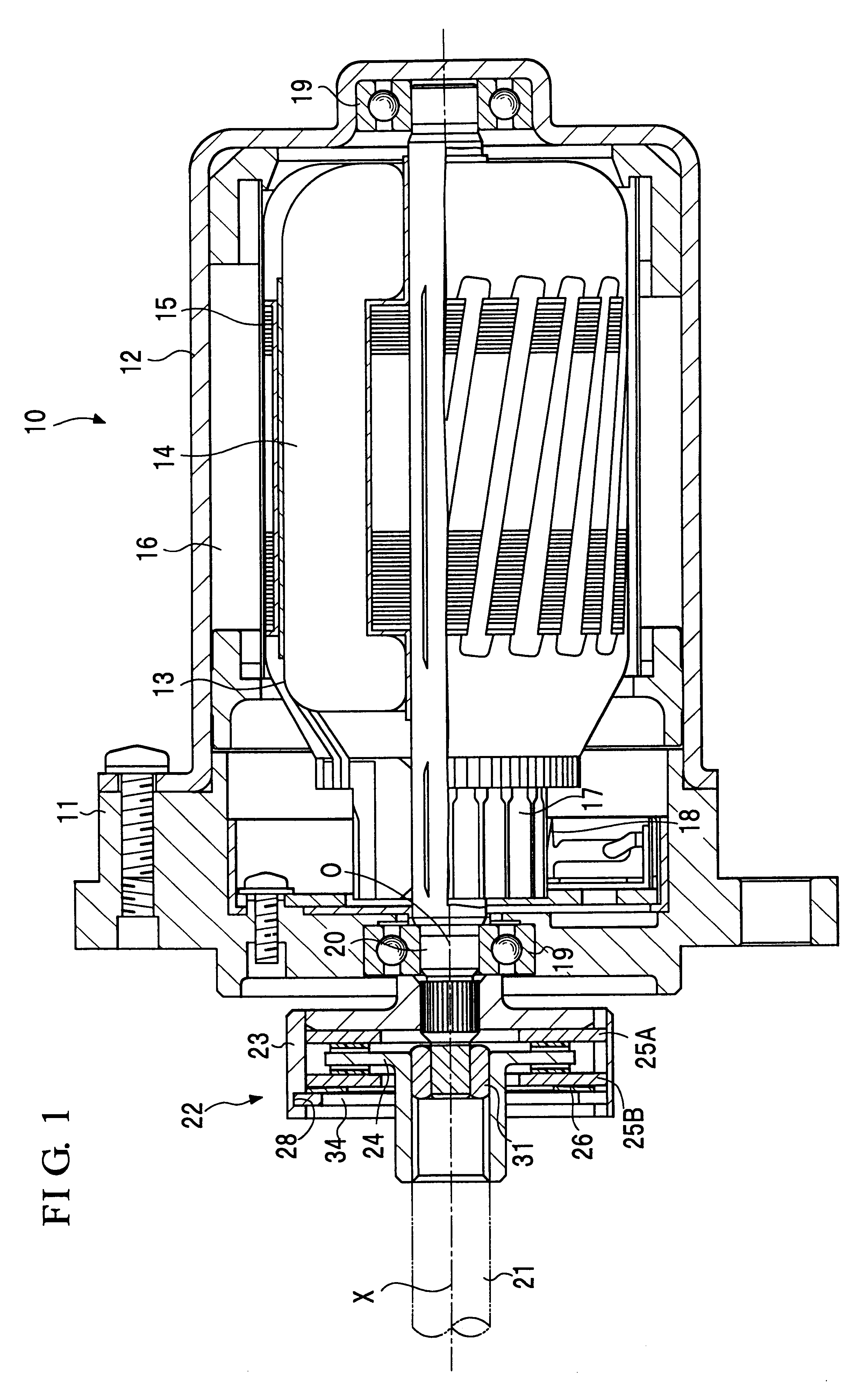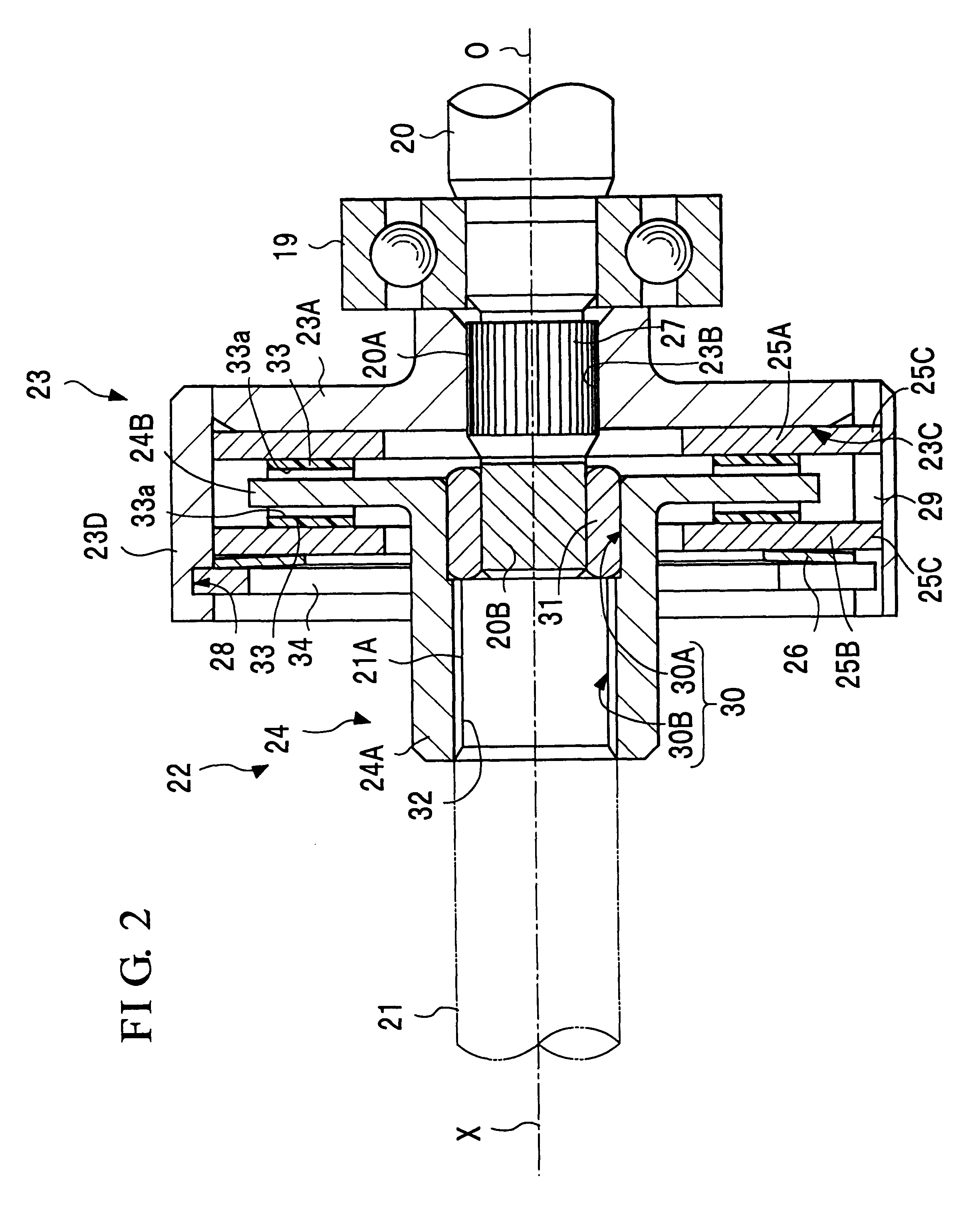Power steering system
a technology of power steering and steering shaft, which is applied in the direction of electric steering, slip coupling, vehicle components, etc., can solve the problems of degrading the follow-up capability between the rotation of input shaft 3 and the rotation of output shaft 2, and the inability to provide predetermined frictional force, so as to reduce the moment of inertia and accurately determine the pressing force
- Summary
- Abstract
- Description
- Claims
- Application Information
AI Technical Summary
Benefits of technology
Problems solved by technology
Method used
Image
Examples
first embodiment
FIGS. 1-3 shows the present invention. In this embodiment, driving unit 10 corresponds to a conventional motor which includes bracket 11, yoke 12, armature 13, coil 14, core 15, magnet 16, commutator 17, brush 18, bearing 19, and output shaft 20. This output shaft 20 is coupled via torque limiter 22 to input shaft 21 of a steering unit of a vehicle or the like (not shown). The torque limiter 22 comprises limiter cover 23 as a rotating member of the present invention, attached such that this cover is rotatable together with output shaft 20, limiter plate 24 as a rotated member of the present invention, attached such that this plate is rotatable together with input shaft 21, and forcing member 26 for forcing this limiter plate 24 onto limiter cover 23 via a pair of cover disks (i.e., friction plates) 25A and 25B and realizing the integral rotation of limiter plate 24 and limiter cover 23 by frictional force generated by the forcing operation.
The output shaft 20 has a step-form structu...
second embodiment
According to the power steering system of the second embodiment as constructed above, flange portion 24B of limiter plate 24 forced by forcing member 26 is in contact with facing material 33 adhered on the upper surface 41A of the convex portion 41. Therefore, even though cover disk 25A is omitted at the bottom face 23C of limiter cover 23, it is only required that the upper surface 41A of the convex portion 41 is processed to have specific flatness. That is, in comparison with the entire bottom face 23C being similarly processed, time and labor can be reduced to improve efficiency, and limiter plate 24 and limiter cover 23 can be firmly in contact with each other and uniform frictional force can be generated.
It is also possible that, instead of providing convex portion 41 on the bottom face 23C of limiter cover 23, a facing material as mentioned above may be directly adhered on the bottom face 23C so as to make limiter plate 24 in contact with the upper surface of the facing materi...
third embodiment
FIGS. 5 and 6 show the arrangement of the In these figures, parts identical to those in FIGS. 1-4 are given identical reference numerals, and explanations thereof are omitted.
In torque limiter 72 of the present embodiment, limiter cover 23 itself is deformed so as to support forcing member 26, and only one cover disk 25 is provided between flange portion 24B and forcing member 26, as in the case of the above-explained second embodiment.
At the opening side of the cylindrical portion 23D of limiter cover 23, wall portion 23E is formed, in which the inner-peripheral area has two kinds of diameters and thus the larger diameter portion has a thinner wall thickness. In addition, step portion 23F is formed at the bottom face 23C side of the wall portion 23E. Furthermore, at some areas, closer to the bottom face 23C side than the step portion 23F, in the inner surface of cylindrical portion 23D, plural (three in the present embodiment) projecting portions as convex fitting portions 129 are...
PUM
 Login to View More
Login to View More Abstract
Description
Claims
Application Information
 Login to View More
Login to View More - R&D
- Intellectual Property
- Life Sciences
- Materials
- Tech Scout
- Unparalleled Data Quality
- Higher Quality Content
- 60% Fewer Hallucinations
Browse by: Latest US Patents, China's latest patents, Technical Efficacy Thesaurus, Application Domain, Technology Topic, Popular Technical Reports.
© 2025 PatSnap. All rights reserved.Legal|Privacy policy|Modern Slavery Act Transparency Statement|Sitemap|About US| Contact US: help@patsnap.com



